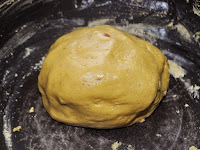Egg and Soldiers is an English breakfast favourite. But
if you struggle to boil eggs, or just can't be bothered, then why not try
steaming an egg or two on top of a deliciously crisp Malabar (Kerala) paratha?
Once it’s done, tear off pieces of paratha to form the “soldiers” and dip them
in the runny egg yolk. Serve with typical English breakfast items, such as
grilled tomatoes, mushrooms, and sausages. Alternatively, serve with
spicy coriander-mint chutney.
This recipe was inspired by the Frankie, a popular Indian
street food in which a chapati is topped with a beaten egg, cooked through, and
stuffed with spicy filling. Parathas don't roll up very well, but they
nevertheless make a delicious base for a cooked egg. You can buy parathas ready
cooked in most Indian shops in the UK; alternatively, you can use leftover
parathas as long as they're reasonably intact.
Ingredients:
1/2 to 1 teaspoon oil or ghee
1 Malabar paratha, cooked
1 egg
Salt
Pepper
Garam masala (optional)
Method:
 1. Heat the oil or ghee in a non-stick, lidded frying pan
over a low-medium flame. Gently place in paratha into the hot oil and fry for 1
minute or so, until the underside is crisp and golden.
1. Heat the oil or ghee in a non-stick, lidded frying pan
over a low-medium flame. Gently place in paratha into the hot oil and fry for 1
minute or so, until the underside is crisp and golden.2. Reduce the flame to low. Flip the paratha and crack the egg into the middle. Carefully spread the egg white around the surface of the paratha with a spatula, keeping the yolk as central as possible. Don't worry if the white leaks into the pan. Cover and cook for 1 minute, or until the white is opaque and the underside of the paratha is crisp.

3. Remove from the heat and season with salt, pepper and garam masala. Tear off strips of paratha and dip them in the runny yolk.
Notes:
- Covering the pan in step 2 allows the steam to cook the egg white. If you leave it uncovered, the underside of the paratha may burn before the egg white is fully cooked.







